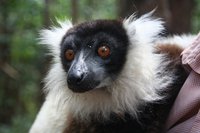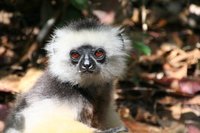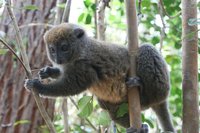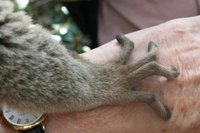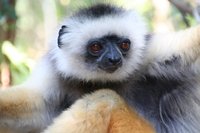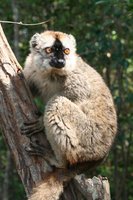 |
 |
 |
Lemurs
All species of lemur are endemic to Madagascar (and in the neighbouring Comores Islands). They are a kind of primate, which means it is related to apes and humans. You would never know it from the way it looks though! Lemurs live in a variety of habitats. Some live in moist, tropical rainforests, while others live in dry desert areas and hence, many different types have evolved.
Most have long, pointy noses, which contribute to their excellent sense of smell. Each type of lemur looks very different. They vary in colour from reddish brown to grey, and come in all different sizes, too. The smallest lemur, the Pygmy Mouse Lemur, weighs only one ounce. But the biggest lemurs, the Indri and Diademed Sifaka Lemur, can weigh up to fifteen pounds, which is about as much as a big cat. The current scientific register lists 101 species and sub-species of lemur of which 8 are Critically Endangered, 18 Endangered, 15 Vulnerable and 4 Near Threatened. At least 17 species have become extinct in the last 2000 years. Lemurs use their sense of smell to communicate with each other. They have scent glands on their bottoms and on their feet that leave odours on surfaces they cross. When other lemurs pass by, they smell those odours and can tell that another lemur has been there. Lemurs have big, bushy tails that they wave in the air as another form of communication. These big tails also help lemurs balance when they leap from tree to tree. The Indri is the only tail-less lemur.
Most lemurs are arboreal, which means they spend most of their time in trees and bushes. They have a good grip for hanging on to branches. Only the Ringtail lemur spends most of its time on the ground. Usually lemurs that are awake during the day live in groups. Besides using scent glands and tails to communicate, they also make noises. Nocturnal lemurs, that are active at night, tend to live alone.
Lemurs don’t have a sphincter muscle and hence, they are constantly dropping faeces, which makes it easier to hear a nearby group! When lemurs are born, they are carried in their mothers' mouths until they are old enough to hang on to her fur by themselves. Most lemurs live for about eighteen years. Lemurs usually have a vegetarian diet, consisting of leaves and fruit, although they will occasionally eat insects or smaller animals. Conservation & Ecology Lemurs play an important role in the ecology of Madagascar and the Comores Islands, because they disperse seeds from the fruit they eat. These seeds can then grow into new plants, which is important because the forests of Madagascar are being destroyed at a very high rate.
Lemurs are threatened largely because their habitats are being destroyed. People in Madagascar cutdown the forests there to use the wood, and to grow agricultural crops in its place. In fact, eighty percent of the lemur's original habitat in Madagascar has been destroyed. Although the lemursthemselves help to disperse seeds for new plants, they cannot keep up with the people that cut the forests down. Lemur populations are also hurt by hunting. Fortunately, however, all types of lemurs
are protected by CITES, which makes it illegal
hunt or capture lemurs for trade, except
for scientific research, and to breed in
zoos. These laws are well-enforced, and the
lemur has been a long-timefocus of conservation
efforts. But although the lemurs are no longer
being hunted as much as in the past, deforestation
is still threatening their survival. | |||||||














